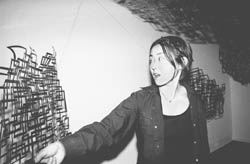|
News
|
|
|
Perspectives
|
|
|
Arts
|
|
|
Sports
|
|
|
Other
|
|

Aoki's Exhibit Employs Soft Light, Dual Images
by Nick Stillman

|
|
A Room With A View: Kyoko AokiÕs moody, understated exhibit Four Frames will be on display till Tuesday.
(photo by Pauline Shapiro)
|
Not many student art shows make as strong a first impression on the viewer's mood as senior Kyoko Aoki's Four Frames, exhibited in Fisher Hall until Tuesday. Aoki transforms the space into one of ethereal moody elegance, creating a quietly powerful atmosphere that makes the viewer lower his or her voice to a whisper and become absorbed within the meditative sensation Aoki's installation induces. She succeeds in creating the serene mood through her subtle use of dim lighting, giving the exhibit as a whole a refreshingly atmospheric aspect.
Three of the pieces are suspended by thin wiring, which is rendered nearly invisible by the soft lighting, creating the sensation that some of the components of her pieces are floating. Aoki uses small white and red lightbulbs to illuminate these same three pieces. While much contemporary art explores the expressive qualities of flamboyantly loud color, the subdued white and red lighting Aoki employs radiates a quiet emotive profundity.
The first piece the viewer encounters when entering from Fisher's south side is a suspended rectangle of plexi-glass, adorned with small three-dimensional squares constructed from thin tissue paper and toothpicks. When viewed from the front, the dim white lighting Aoki uses to illuminate the piece creates an eerie visual effect - the viewer is unable to discern which side of the transparent field the objects are actually on.
The viewer ultimately becomes a part of the piece and is forced to address the phenomenon of the "other side" - although one can see through to the other side, a transparent barrier prevents entry into it. The other side Aoki constructs appears imminently more appealing, as the squares are arranged neatly in front of the infinitely white backdrop.
Aoki uses a dim red bulb to light another piece, and while the soft light illuminates the particular work, the glow radiates throughout the room, affecting the exhibit as a whole. The bulb is suspended between two pieces of painted paper, meticulously cut into an array of hard-edged shapes resembling converging shards of glass. The red light projects these suspended objects onto two flanking pieces of white paper, which serve as screens. The projections of the original objects are obscured and softened, the edges become soft and blurred, ultimately creating a new image, forcing the viewer to confront the duality and decide which is "real."
Two similarly cut objects are placed on a central pedestal within the piece. The lighting causes these pieces to cast a dramatic shadow on the starkly white pedestal and the materiality of the objects becomes confused with the bold shadows.
Another piece displays four hanging objects against blank white walls. Three of the objects are complex diagrams, resembling microchips. Only one of the diagrams includes text, as "Carry in" and "Carry out" inconspicuously appear at the top and bottom, making the viewer reflect on the complexity and confusion of 21st century labor. Moreover, these objects serve a dual function - they act as mirrors. While contemplating futuristic notions of labor and work the viewer finds him or herself looking into his or her own eyes.
The centerpiece of this piece is a rough, rectangular frame with small squares, bound by pins, projecting out into space. Aoki uses a white light for this piece, again creating a bold shadow behind the projected objects. The squares decrease in size from top to bottom, converge wildly in the middle and become sparse at the bottom, potentially allegorical for a life cycle.
What this piece lacks in dynamic motion, the piece on the north side of Fisher makes up for. It is an incredibly dramatic work, as Aoki has suspended eight large sheets of paper across the thin hall. While in the aforementioned piece various discordant shapes are cut into the paper, creating an angular stencil-like effect, the shapes Aoki creates with these sheets are all composed of right angles, recalling the harmony and unified balance of Theo van Doseburg's dynamic de Stijl work. A lone white bulb illuminates the sheets from the center, causing dramatic reflections to cascade along the walls. One feels a dizzying sense of motion upon entering the hall, accentuated by the surprising revelation that the viewer's shadow is incorporated as an integral part of the piece.
Aoki's installations exude a quiet stately power, felt most intensely in this piece. Light is clearly an essential element in her work and while it would be presumptuous to conclude the soft illumination of her pieces is a reference to her Japanese heritage, it does recall Asian urban and interior lighting.
The use of materials is also significant in Aoki's pieces, as she displays a consistent tendency to make use of everyday objects not normally considered integral to art.
The cleverness of Aoki's work lies in her ability to construct dualities through the creation of boundaries or frames. The viewer is constantly presented with an "other side," causing a significant amount of social self-reflection, as Aoki's pieces so consistently include the viewer. While this is the ideological strength in Aoki's work, her foremost formal strength is her ability to create an atmosphere conducive to reflection and meditation through her powerful use of light and shadow. It is this subtle elegance that makes Aoki's delicately ethereal pieces so vigorously exciting.
Copyright © 2000, The Oberlin Review.
Volume 129, Number 12, December 15, 2000
Contact us with your comments and suggestions.